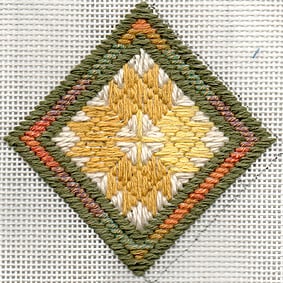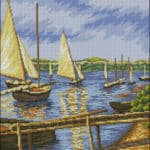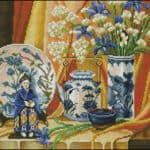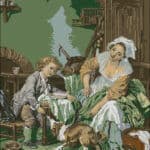How To Needlepoint
Needlepoint Instruction and Tips
Needlepoint is worked with wool or thread over canvas and the stitches cover the whole area, including the background. This means that the finished embroidery is strong, heavy and very durable, making it particularly suitable for upholstery and soft furnishings, such as footstools, cushion covers, chair seats, rugs and decorative wail hangings. It is also ideal for small, practical items like spectacle cases and purses.
One of the great attractions of needlepoint is that beautiful and useful objects can be created with the minimum of materials and equipment. Canvas, needles, threads and a tapestry frame are all that are really required.
CANVAS
Canvas produced specifically for needlepoint is constructed from an even mesh of horizontal and vertical threads. As well as canvas made from cotton, which has been used to create the projects in this book, canvas is available in linen, silk and plastic. Plastic canvas is a particularly good medium for children to learn needlepoint on, as the holes are large and easier to work, and mistakes can easily be cut out or unpicked without damaging the canvas.There are two types of canvas in general use: one is woven with single threads (mono canvas), and the other with double threads (duo canvas), which has pairs of threads running vertically and horizontally. The projects in this book are worked on both single-and double-thread canvas. Canvas is graded by the mesh size, which is the number of stitches it gives to the inch (2.5cm), also referred to as the ‘count’. Thus 10 count canvas has 10 holes to the inch (2.5cm).This can be gauged by counting the number of holes to the inch (2.5cm). The finer the canvas, the more holes there are to the inch. The designs in this book are worked on various mesh sizes. If you wish to alter the size of the finished embroidery, choose a canvas which
has more (or less) holes to the inch, and the finished design will be smaller (or larger) accordingly.
Needlepoint Thread and Yarn
There are many different types of needlepoint thread and yarn and it can sometimes be confusing what to use on a particular canvas. We give you a basic list of the different types of needlepoint thread and yarns and when/how to use them.
NEEDLES
Needlepoint is worked with tapestry needles which have a blunt point. They are available in various
numbered sizes to suit the canvas mesh size being worked on. The finer the needle, the higher its number. The needle should pass through the canvas easily without pushing the threads apart and the eye should be held in place by the canvas threads without allowing the needle to fall through. For example, use a No.18 tapestry needle on 10 mesh duo canvas, and a No.24 on 14 mesh mono canvas. The size of needle required for each design is given with the project.
As most needles are made of steel, they tend to tarnish or rust with age. Therefore, do not leave your needle in the design area when you are not working on the embroidery, as it can leave unsightly marks on the canvas or thread. If you find that your needle does become tarnished, or rough to the touch through use, it is best to discard it, as it may catch and damage the canvas and thread.
You may think it worth the investment to buy gold-plated or even platinum needles which are now available in many needlework shops. They are a pleasure to use, as they slide through the canvas with less friction and will not rust or mark the canvas.
TAPESTRY FRAMES
It is advisable to work needlepoint on a rotating wooden frame, either a floor-standing model for larger projects, or a hand-held frame for smaller ones. Both are available in several sizes. The frame consists of two horizontal rollers with tapes onto which the canvas is sewn. These rollers slot into two vertical stretchers and are held in place by screws and wing-nuts. The canvas is rolled onto the rollers until it is taut, and then is laced to the stretchers. The frame holds the canvas at a permanent tension: this makes it easier to work, keeps the stitching even and helps to maintain the shape of the canvas until the needlepoint is finished. When buying a frame, pay particular attention to the smoothness of the wood from which it is made, and the free running of the rollers. Do not use an embroidery hoop, as they are unsuitable for canvas work.
See also needlepoint designs free download
Don’t miss embroidery design for neck











Merci pour ces très beaux motifs que je vais utiliser pour les cadeaux à mes enfants. d’autres seront brodés sue des taies d’oreillers et coussins pour le trousseau de ma fille. Merci encore une fois.